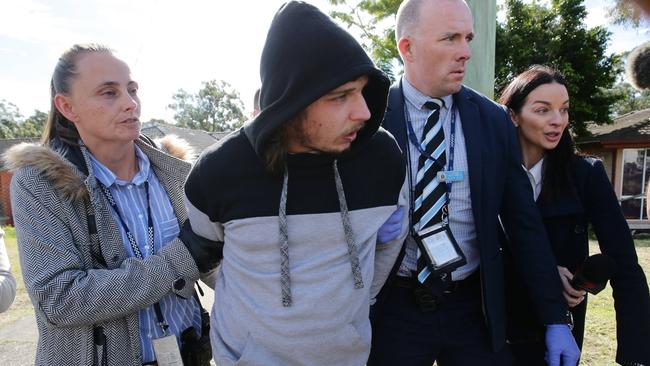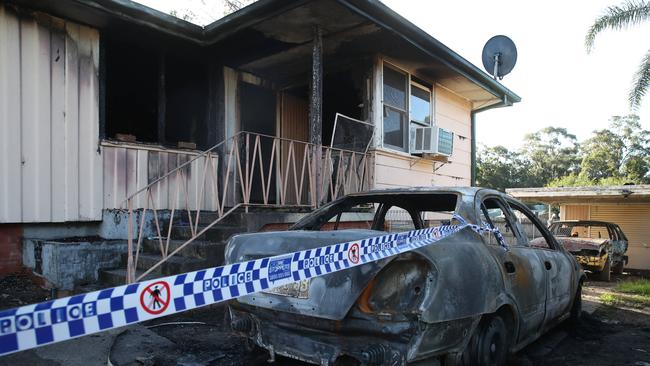Harley Thompson: Supreme Court finds Nowra man ‘not criminally responsible’ of fatal fire
A South Coast man accused of murdering his neighbour by setting fire to his house has learned his fate. Find out what happened in court.
The South Coast News
Don't miss out on the headlines from The South Coast News. Followed categories will be added to My News.
A Bomaderry man accused of murdering his neighbour by setting fire to his house has learned his fate during a special hearing at a South Coast court.
Harley Thompson, 27, was charged with murdering Cameron Robert Johnson after starting the fatal inferno only four doors down from his own home on August 2, 2020.
Mr Johnson, 49, was inside his home on Leonard St in Bomaderry when a fire started in his lounge room. Multiple fires were then lit around the perimeter of the house, causing it to burn to the ground, according to a triple-0 call tendered to the court.
Mr Johnson could not escape the blaze, with a forensic pathologist report saying he died of smoke inhalation. His 21-year-old son, who has special needs, escaped the blaze.
At a special hearing of the NSW Supreme Court sitting at Nowra, Justice Michael Walton found the act of murder proven, but said Thompson was not criminally responsible.
Justice Walton ruled in favour of clinical evidence that stated Thompson likely suffered from undiagnosed mental illness, and was in a state of psychosis at the time of the fire.

“I am satisfied Thompson knew of the nature and quality of his actions, but did not reason with a moderate degree of sense and composure about whether it was wrong,” he said.
Clinical psychiatrists Kerri Eagle and Andrew Ellis had assessed Thompson while in custody.
Both doctors agreed Thompson likely suffered from undiagnosed schizophrenia.
During interviews with Dr Eagle and Dr Ellis referenced in court, Thompson complained of hearing voices in his head and had fixated on a belief Johnson was a paedophile.
Thompson further believed he had been in an altercation with Mr Johnson prior to the fire, which had led him to vandalise Mr Johnson’s house twice that evening prior to setting it alight.
Evidence of any alleged pedophilic activity by the deceased was “flimsy and questionable”, Justice Walton said, and was further evidence of Thompson’s psychosis.
After being briefly admitted to a Victoria hospital in 2019, Dr Ellis had previously told the court Thompson exhibited behaviour consistent with someone with an underlying condition.
Once in custody, Thompson was treated by an on-site psychiatrist who ruled that Thompson was likely suffering from an undiagnosed psychotic disorder, Justice Walton told the court.
His condition improved after being put on a regimen of antipsychotic medications.

In passing down his judgment, Justice Walton referred to a number of lies Thompson had made both in evidence to doctors Ellis and Eagle, and during a police interview.
In letters to his mother and former partner, Thompson had admitted to starting the fires, telling his mother he wanted to see Johnson “burn”, but made no reference to voices.
Dr Ellis said Thompson likely understood the voices to be normal, and not worth mentioning.
In his evidence, Dr Ellis further referred to lies Thompson had made about the quantity of methamphetamine he had used on the day and when he had first claimed to have heard voices in his head as evidence of Thompson being an “unreliable narrator”.
Justice Walton agreed with Dr Ellis’ submission that the lies suggested that he was not faking symptoms, and that the lies were driven by a “naive motive” to secure bail.
A victim statement tendered to the court by David Johnson was assessed by Justice Walton. It was not read aloud in open court.
Justice Walton told the court Robert Johnson was in a state of fear at the time of his death.
“It is clear that Johnson and his son were terrified of Thompson during the incident,” he said.
“Johnson consistently described Thompson as scary and capable of smashing through the front door, as evidenced by recordings of triple-0 calls.
“Johnson said that he did not want to look outside and that he was hiding from Thompson because he feared Thompson would kill them.”
Thompson was ordered under Section 31 of the Mental Health Act to be detained at a correctional facility until a health tribunal determines him fit to be released.
A review by the tribunal will be held soon and will be reassessed on a six monthly basis.
Should he be released, Thompson will be placed under specific conditions, including monitoring for any deterioration in his mental health.




